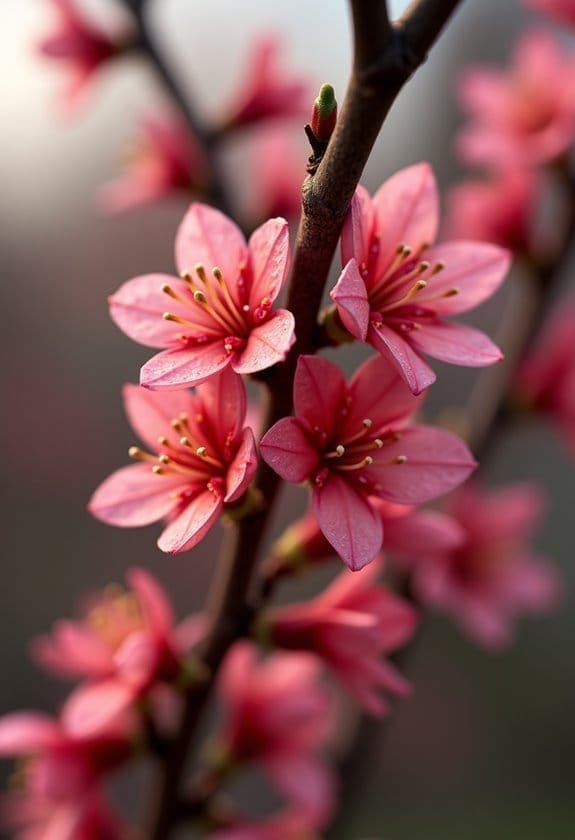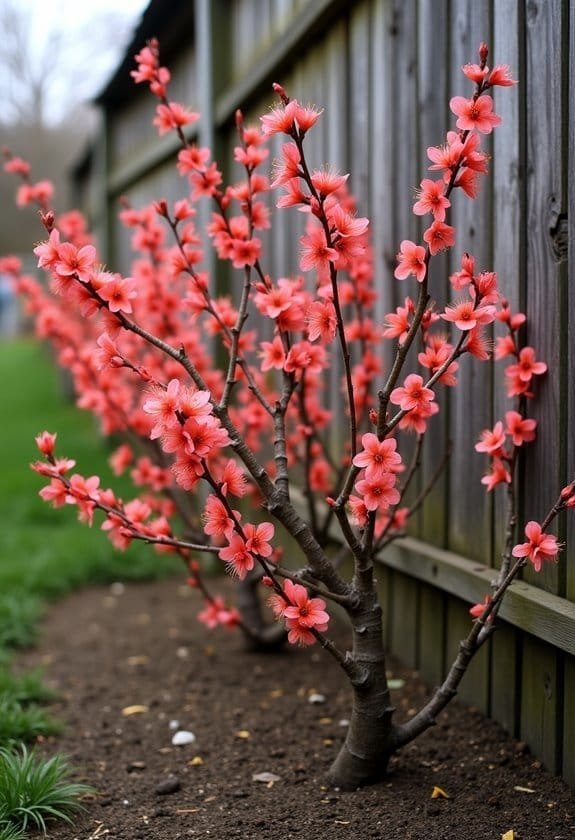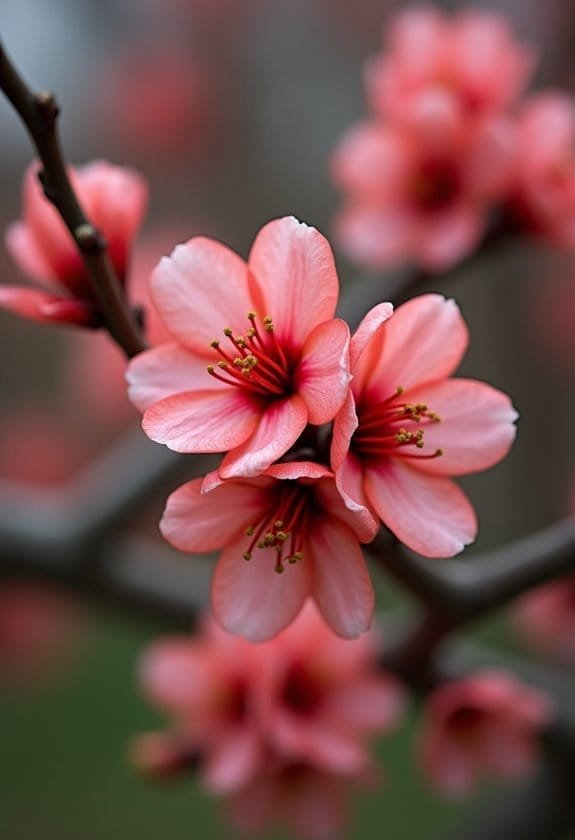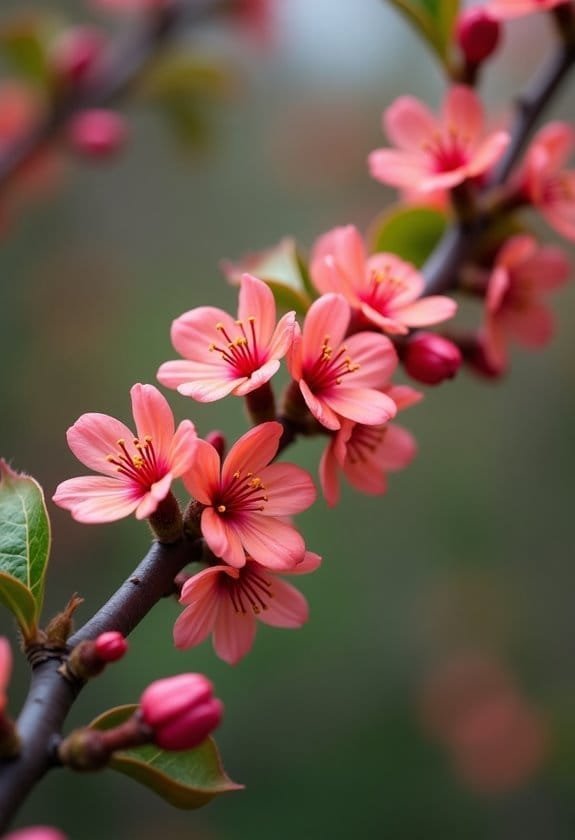Chaenomeles speciosa, known as Japanese Quince, is a striking ornamental shrub from the Rosaceae family that produces vibrant early-spring blossoms and edible, apple-shaped fruits. This hardy plant thrives in USDA zones 5-9, reaching heights of 2-3 feet with a spread of 3-6 feet, though some cultivars can grow up to 10 feet tall. It's prized for its 3-4 cm diameter flowers in shades of orange, red, pink, or white, which appear before the foliage and attract essential pollinators. The vitamin C-rich fruits mature in autumn, measuring 2-3 inches across, making them perfect for jellies and preserves. The plant's dense, thorny structure and adaptable nature offer countless possibilities for both ornamental and practical garden applications.
Main Points
- Japanese Quince is an ornamental shrub from East Asia that produces vibrant early-spring flowers and edible, apple-shaped fruits.
- The plant grows 2-3 feet tall, spreads 3-6 feet wide, and thrives in USDA zones 5-9, tolerating temperatures down to -25°C.
- Flowers bloom before foliage in late winter to early spring, displaying orange, red, pink, or white blooms measuring 3-4 cm.
- Fruits mature in autumn, measuring 2-3 inches across, and contain high levels of pectin and vitamin C for jelly making.
- Plants require well-draining soil, six hours of sunlight daily, and regular pruning to maintain shape and prevent disease.
Introduction

Chaenomeles speciosa, commonly known as Japanese Quince, stands as a remarkable member of the Rosaceae family native to the diverse landscapes of East Asia.
This thorny deciduous shrub has earned its place in gardens worldwide for its stunning early-spring display of orange to red blossoms, which emerge before its leaves in late winter.
The species combines ornamental appeal with practical benefits, producing edible fruits high in pectin while serving as both a protective barrier and an important resource for pollinators in zones 5-9.
Common Name
Commonly known as Japanese Quince or flowering quince in horticultural circles, this ornamental shrub stands out for its early-blooming flowers that burst into vibrant displays of orange, red, pink, or white.
The Chaenomeles speciosa has earned its widespread recognition through its remarkable ability to provide spectacular winter interest when most gardens lie dormant.
The plant's common name reflects its historical association with Japan, though it's worth noting that the species actually originates from China.
In gardening communities worldwide, the term "flowering quince" has become increasingly prevalent, emphasizing the plant's ornamental qualities rather than its fruit-bearing characteristics.
While the shrub does produce apple-shaped fruits in early fall, these bitter offerings aren't typically consumed raw, leading to a stronger focus on its decorative aspects.
The compact nature of this hardy specimen, growing just 2 to 3 feet tall with a spread of 3 to 6 feet, has helped cement its position as a versatile garden staple, particularly in regions where winter temperatures can plummet to -25°C.
Scientific Name
The scientific name that botanists use to classify Japanese quince is Chaenomeles speciosa, a member of the expansive Rosaceae family. This taxonomic classification places it in close genetic proximity to familiar fruits like apples and pears, reflecting their shared ancestral origins and botanical characteristics.
While Chaenomeles speciosa represents the most widely recognized species, it's often confused with its cousin, Chaenomeles japonica, which is a distinct but related species. The 'speciosa' epithet, derived from Latin, appropriately describes the plant's showy and ornamental nature, particularly evident in its stunning spring blooms.
This scientific designation acknowledges the plant's notable features, including its thorny growth habit and its impressive maximum height of 2 meters.
The classification within the Rosaceae family helps explain several of the plant's distinctive traits, from its flower structure to its fruit characteristics. Originally documented in East Asia, particularly across Japan, Korea, and China, the species has maintained its scientific name despite various common name variations across different cultures and regions.
This taxonomic stability has proven invaluable for botanical research and horticultural applications.
Overview
Native to the diverse landscapes of East Asia, Japanese Quince stands as a remarkable member of the Rosaceae family, prized for its stunning floral displays and versatile fruit production. This resilient flowering shrub, known scientifically as Chaenomeles, has established itself as a cornerstone of ornamental gardening across temperate regions worldwide.
Distinguished by its compact growth pattern, Japanese Quince typically maintains a manageable height of 2 to 3 feet while spreading gracefully to widths between 3 and 6 feet. The plant's thorny stems serve as a natural deterrent to garden pests, while its vibrant blossoms herald the arrival of spring, often emerging while winter's grip still lingers.
Its remarkable cold hardiness, withstanding temperatures as low as -25°C, makes it an excellent choice for gardens in USDA zones 5 through 9.
Beyond its ornamental appeal, this versatile shrub produces aromatic, apple-like fruits that mature in early autumn, offering exceptional nutritional value. The fruits contain impressive levels of vitamin C, surpassing even lemons in concentration, and boast high pectin content that makes them particularly valuable for culinary applications such as jellies and preserves.
Key Features
Japanese quince showcases impressive versatility in its growth pattern, reaching heights between 3 to 10 feet while maintaining a naturally compact form suitable for garden spaces.
The shrub's most striking feature is its brilliant orange-scarlet flowers, which emerge dramatically against bare branches in early spring before the foliage appears.
These hardy plants complement their ornamental display with thorny branches and small, aromatic fruits that measure 2-3 inches in diameter, transforming from yellow-green to golden as they mature.
Growth Size
Ranging from compact shrubs to sizable bushes, Chaenomeles species exhibit varied growth patterns depending on their cultivar and growing conditions. The standard Japanese Quince maintains a modest height of 2 to 3 feet while demonstrating an impressive spread that can extend between 3 to 6 feet, creating a balanced horizontal profile in garden settings.
Certain cultivars, particularly Chaenomeles japonica, showcase more substantial growth potential, reaching impressive heights of up to 10 feet with their characteristic multi-stemmed architecture.
The shrub's distinctive growth pattern features an open, spreading habit where thorny stems interweave to form an intricate network of branches. This natural architecture not only provides visual interest throughout the seasons but also serves as an effective barrier or security feature in landscape designs.
The plant's growth structure supports its seasonal displays, with dark green oval leaves spanning 1 to 4 inches creating a verdant backdrop.
During the late winter to early spring flowering period, the branches burst forth with vibrant orange to orange-red blooms measuring up to 1.5 inches across, perfectly proportioned to the shrub's overall dimensions.
Appearance
The distinctive Chaenomeles shrub presents a striking combination of thorny stems, glossy foliage, and vibrant blossoms that create year-round visual interest. Known commonly as Flowering Quince, this ornamental plant showcases an intricate network of thorny branches that serve both defensive and aesthetic purposes, contributing to its architectural appeal in the landscape.
During late winter to early spring, the shrub bursts into spectacular bloom, producing vivid orange to orange-red flowers measuring up to 1.5 inches in diameter. These blossoms emerge before the foliage, creating a dramatic display against the bare branches.
The plant's oval-shaped leaves, measuring 2 to 4 inches in length, later unfold to reveal a glossy green surface that persists throughout the growing season. By early fall, the shrub develops small, aromatic fruits that measure 2 to 3 inches across, displaying a yellow-green hue as they reach maturity.
These fruits complement the plant's overall appearance while providing additional ornamental value, transforming the shrub into a multifaceted specimen that maintains visual interest through multiple seasons.
Flowering Season
When winter's grip begins to loosen, Chaenomeles bursts into spectacular bloom, producing vibrant flowers that herald the arrival of spring. The flowering period, which precedes leaf emergence, showcases an abundance of 3-4 cm diameter blossoms in striking shades of orange-red, pink, and white.
These early-blooming shrubs provide an essential splash of color during the shifting period between seasons, with their flowers persisting for several weeks. The distinctive blooms feature delicate creamy-white stamens that contrast beautifully with the vibrant petals, creating an eye-catching display that attracts early-season pollinators.
Ideal flower production depends greatly on exposure to full sunlight, which encourages the development of numerous blooms across the plant's branches.
The timing of this flowering phase is particularly important in the plant's life cycle, as it occurs well before the development of its fruit. This early bloom strategy guarantees adequate pollination time and allows the subsequent fruit to develop throughout the growing season, making Chaenomeles both ornamentally valuable and horticulturally productive.
Growing Requirements

Japanese quince demonstrates remarkable adaptability in USDA zones 5-9, flourishing in both full sun and partial shade conditions that support its distinctive flowering patterns.
The shrub's versatility extends to its soil preferences, as it tolerates various substrates from clay to loam, though it requires proper drainage and slightly acidic conditions to prevent nutrient deficiency issues.
While established plants show impressive drought tolerance, consistent moisture through moderate watering practices, particularly during fruit development, guarantees ideal growth and productivity.
Light
Growing Chaenomeles species successfully depends heavily on proper light exposure, with these ornamental plants thriving best in full sun conditions. The plant's flowering performance and overall health are notably enhanced when it receives abundant direct sunlight throughout the day, particularly during its essential blooming period from late winter to early spring.
While Japanese Quince demonstrates remarkable adaptability to varying light conditions, ideal growth requires a minimum of six hours of direct sunlight daily. In situations where full sun exposure isn't possible, these resilient plants can adapt to partial shade environments, though gardeners should expect a corresponding reduction in flower production.
The relationship between light exposure and bloom abundance becomes particularly evident in less-than-ideal conditions, where insufficient sunlight often results in elongated, spindly growth patterns and diminished flowering.
To maximize the plant's ornamental potential and maintain its compact, well-branched structure, positioning Chaenomeles in a location that receives unobstructed sunlight throughout the growing season remains essential for achieving the spectacular floral display these species are capable of producing.
Soil
Successful cultivation of Chaenomeles species extends beyond proper light exposure to soil requirements, where well-draining, loamy conditions support ideal growth.
These adaptable plants demonstrate remarkable versatility, thriving in various soil compositions, from rich loam to challenging clay environments, making them suitable for diverse garden settings.
For peak growth, gardeners should maintain soil pH levels between 6.0 and 7.0, as this slightly acidic to neutral range prevents chlorosis, a condition that manifests as yellowing foliage when plants struggle to absorb essential nutrients.
While Japanese Quince exhibits commendable drought tolerance once established, consistent soil moisture greatly enhances fruit production and overall plant health.
A protective layer of mulch serves dual purposes: preserving precious soil moisture and preventing unwanted weed competition, particularly beneficial during the critical establishment phase of young specimens.
Careful attention to soil drainage remains paramount, as waterlogged conditions can foster destructive fungal diseases that compromise root health, potentially leading to the plant's decline if left unaddressed.
Water
Despite their drought-tolerant nature, Chaenomeles species require consistent watering practices to achieve ideal growth and fruit production, especially during their initial establishment period.
When cultivating these ornamental shrubs, it's vital to maintain regular soil moisture without oversaturating the root zone, particularly during extended dry spells.
Water management plays an important role in the successful cultivation of Japanese Quince, with specific attention needed for proper irrigation techniques.
Directing water at the soil level, rather than using overhead sprinklers, helps prevent leaf burn and reduces the risk of fungal diseases that can develop on wet foliage.
Young plants are particularly vulnerable to water stress, making it necessary to eliminate competing weeds that might deprive them of vital moisture during their establishment phase.
To optimize water retention and promote healthy growth, applying a layer of organic mulch around the base of the plant proves highly beneficial.
This practice not only conserves soil moisture but also helps regulate soil temperature and gradually enriches the growing medium as the mulch decomposes over time.
Temperature
Japanese Quince plants exhibit remarkable temperature tolerance, adapting to a wide range of conditions from -25°C in USDA zones 5-9. Their resilient nature allows them to withstand harsh winter temperatures while still producing vibrant spring blooms, making them a versatile choice for diverse climate zones.
These hardy shrubs demonstrate peak performance when exposed to full sunlight, which directly influences their flowering capacity and overall vigor. While they can tolerate partial shade, reduced sun exposure typically results in diminished blooming potential.
The plants' temperature adaptability comes with one notable caveat: early spring frosts can pose a significant threat to developing flower buds. In regions prone to late frost events, protective measures become essential to safeguard the plant's flowering potential.
Gardeners in colder climates often employ frost blankets or strategic placement near structures to minimize damage during unexpected temperature drops. Despite these challenges, Japanese Quince's broad temperature tolerance makes it an excellent choice for gardens across multiple climate zones, provided proper consideration is given to local frost patterns and sun exposure.
Pollinator Criteria
Japanese quince serves as a vital early-season resource for pollinators, with its vibrant orange-to-red blooms attracting diverse bee and butterfly species when few other plants are flowering.
The abundant floral resources, including nectar-rich blossoms and prominent stamens, make this species particularly appealing to essential pollinating insects during the vital spring emergence period.
Beyond providing sustenance, the plant's dense, thorny structure creates protective microsites where pollinators can safely rest and shelter while moving between flowers, enhancing their survival and pollination efficiency in garden environments.
Attracted Pollinators
Among early spring bloomers, Chaenomeles species serve as significant nectar and pollen sources for various pollinators. The Japanese Quince, in particular, attracts an impressive array of beneficial insects with its vibrant orange, red, and pink blossoms that emerge before most other garden plants awaken from winter dormancy.
These early-season flowers provide essential sustenance for emerging pollinators when food resources are remarkably scarce.
The shrub's architectural structure plays an important role in its pollinator-friendly characteristics, as its open, spreading habit creates multiple access points for visiting insects. Honeybees frequently visit the flowers, gathering both nectar and pollen to support their colonies' spring build-up, while diverse species of solitary bees and butterflies also benefit from this early-season bounty.
The dense growth pattern of Chaenomeles offers additional ecological advantages, serving as a protective sanctuary for these beneficial insects. This multifaceted support system not only aids pollinator populations but also strengthens the broader ecosystem's resilience by maintaining healthy populations of these significant insects during the critical early spring period.
Pollination Method
The pollination process of Chaenomeles species follows specific criteria that maximize reproductive success. The plant has evolved a sophisticated system that relies heavily on insect pollinators, particularly bees and butterflies, which serve as essential vectors for pollen transfer between flowers.
During early spring, before the leaves emerge, Japanese quince produces vibrant orange to red blossoms that act as visual beacons for emerging pollinators. This strategic timing aligns perfectly with the period when insects emerge from their winter dormancy, ensuring ideal pollination conditions.
The flowers' sweet nectar serves as a natural reward system, encouraging consistent pollinator visits and increasing the likelihood of successful cross-pollination.
The plant's reproductive strategy is particularly significant because fruit development occurs primarily on older wood. This characteristic makes the synchronization between flowering time and pollinator activity vital for fruit set.
When pollination is successful, the results are evident in both the quantity and quality of the small, aromatic pome fruits that develop, ultimately contributing to the species' reproductive success and survival.
Care & Maintenance

Japanese quince requires thoughtful care to thrive, starting with proper planting in well-draining soil and regular spring pruning to maintain its architectural form.
Successful maintenance hinges on consistent monitoring for common pests like aphids and scale, while implementing a strategic watering schedule that accounts for the plant's established drought tolerance.
Companion planting with early-blooming bulbs and shade-tolerant perennials can create a harmonious garden design, though adequate spacing must be maintained to prevent competition for resources and allow for proper air circulation.
Planting Tips
Successful cultivation of Chaenomeles species relies heavily on proper care and maintenance practices. When planting Japanese quince, selecting the ideal location becomes paramount for ensuring best growth and abundant flowering throughout the season.
Site selection should prioritize areas that receive full sun exposure, though these adaptable shrubs can tolerate partial shade conditions with somewhat reduced blooming. The soil composition plays a vital role in establishment, with well-draining clay soils providing an ideal growing medium for these robust plants.
When preparing the planting site, incorporate organic matter to improve drainage while maintaining the soil's moisture-retention capabilities.
Spacing considerations are particularly important, as proper air circulation helps prevent fungal diseases that can affect Chaenomeles species. Plants should be positioned at least 4-5 feet apart to accommodate their mature spread and minimize competition for resources.
It's important to plant at the same depth as the nursery container, ensuring the crown remains slightly above soil level to prevent root rot issues.
Once established, implement a regular maintenance schedule that includes spring pruning and sucker removal to maintain the desired form and promote healthy growth.
Ongoing Care
Maintaining healthy Chaenomeles shrubs requires consistent attention to several key practices. Regular pruning in spring after flowering plays an essential role in shaping the plant and promoting robust fruit production, though gardeners should exercise restraint since flowers develop on old wood.
The ongoing care of Japanese quince involves vigilant pest monitoring, particularly for common invaders like aphids, scale insects, and spider mites. These unwanted guests can be effectively managed using insecticidal soaps or natural alternatives that preserve the plant's liveliness.
Proper spacing between shrubs creates important air circulation, which serves as a natural defense against fungal diseases such as leaf spot and powdery mildew.
While Chaenomeles demonstrates admirable drought tolerance once established, strategic irrigation during dry periods can greatly enhance both fruit yield and overall plant vigor.
To maintain the shrub's health and prevent overcrowding, it's imperative to remove suckers promptly as they emerge from the base. These aggressive shoots can divert energy from the main plant, potentially compromising its development and fruit production potential.
Suggested Companions
Along with proper maintenance, strategic companion planting enhances the health and productivity of Chaenomeles shrubs. The Japanese quince demonstrates remarkable synergy when paired with other fruit-bearing plants, particularly blackcurrants and aronia species, creating a diverse and interconnected growing environment that supports overall garden health.
These companion relationships facilitate improved pollination and create natural barriers against common pests, while promoting vigorous new growth throughout the growing season.
When designing a companion planting scheme, gardeners should consider spacing requirements that allow for adequate air circulation between specimens, reducing the likelihood of fungal diseases and pest infestations. The integration of complementary species not only maximizes available garden space but also creates beneficial microclimates that support the entire plant community.
Common Issues
Japanese Quince faces several significant challenges, with fungal leaf spots emerging during wet seasons and persistent aphid infestations targeting tender spring growth.
A combination of environmental stressors, including early frost damage to flower buds and soil pH imbalances, can lead to chlorosis and compromised plant health.
Regular monitoring coupled with targeted interventions, such as proper soil management and timely pest control measures, helps maintain the shrub's health and ornamental appeal.
Pests/Diseases
Ornamental quince species face several common pest and disease challenges that gardeners should monitor. Among the primary concerns are aphids, which particularly favor fresh spring growth and can weaken the plant by extracting essential nutrients. While these small insects can be deterred with forceful water sprays, persistent infestations might require targeted insecticide applications.
During wet seasons, fungal leaf spots can become particularly problematic, manifesting as dark lesions that may cause premature leaf drop. This condition often intensifies when air circulation is poor, making proper plant spacing and selective pruning essential preventive measures.
Adding to these challenges, apple scab can affect both foliage and fruits, requiring vigilant observation and timely fungicide treatments when symptoms appear. Scale insects and spider mites represent additional threats to plant health, though they're typically manageable through the application of insecticidal soaps.
While leaf burn can occur in intense afternoon sunlight and may lead to temporary defoliation, Japanese quince demonstrates remarkable resilience, typically recovering from such environmental stress without lasting damage to the plant's overall health.
Solutions
When you encounter problems with your Chaenomeles plants, several effective solutions can address common issues. These thorny deciduous shrubs respond well to targeted interventions, particularly when dealing with common pests and diseases that may affect their health and appearance.
For aphid infestations on new growth, a forceful spray of water or application of insecticidal soap provides immediate relief without harming the plant's delicate tissues.
Managing fungal leaf spot requires improving air circulation around the plant, while careful attention to watering practices helps prevent leaf burn in these susceptible specimens. Direct soil watering, rather than overhead irrigation, proves especially essential during intense afternoon sun exposure.
Regular maintenance should include vigilant removal of root suckers, which prevents these vigorous plants from overwhelming garden spaces through excessive spread.
Although scale insects and spider mites rarely pose significant threats to Chaenomeles species, incorporating routine inspections into the care regimen guarantees early detection and swift intervention when necessary.
These preventive measures, combined with proper cultural practices, help maintain the health and liveliness of Japanese Quince specimens.
Summary

Along with its ornamental appeal, Chaenomeles speciosa stands out as a versatile shrub that combines beauty with practicality. This Japanese Flowering quince captivates gardeners with its stunning display of orange to red blossoms that emerge in late winter, creating a dramatic contrast against bare branches.
As a hardy specimen thriving in USDA zones 5-9, this low-maintenance shrub demonstrates remarkable adaptability to various growing conditions, including challenging soil types and partial shade environments. Its compact growth habit, typically reaching 2-3 feet in height, makes it an excellent choice for diverse landscape applications.
While the fruit's bitter nature prevents direct consumption, its high pectin content proves invaluable for culinary purposes, particularly in jellies and preserves. The plant's multifaceted nature extends beyond aesthetics and food production, as it serves as a natural air freshener and holds significance in traditional medicine as a general tonic.
Additionally, its ability to attract pollinators contributes to garden ecosystem health, while its thorny structure provides protective hedging capabilities, making it a truly multifunctional addition to any landscape.


